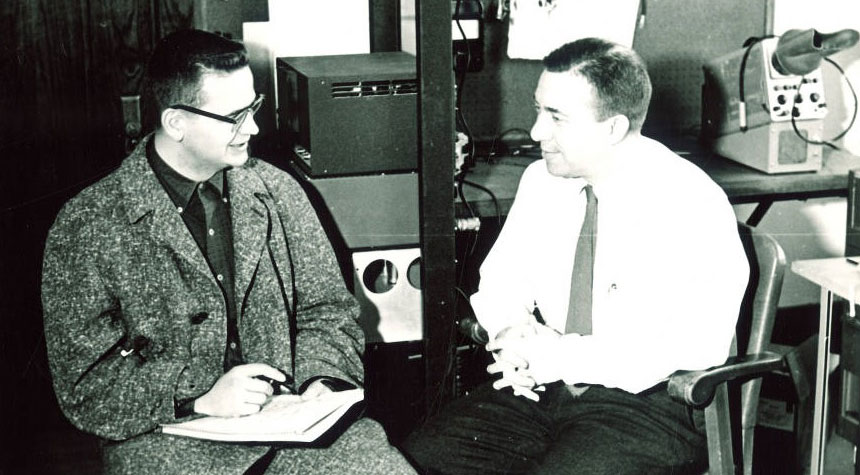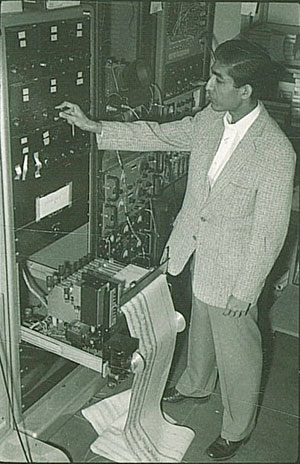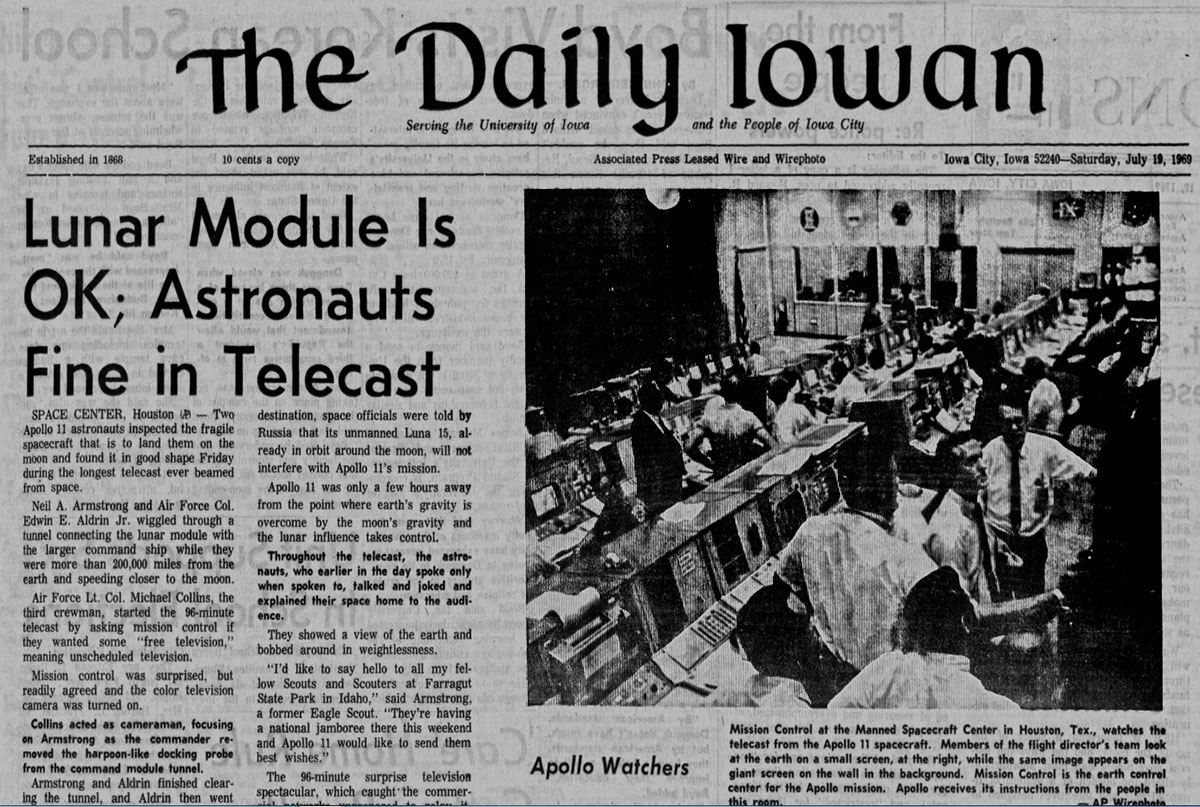Old Gold: How Iowa Research Made the Moon Landing Possible
 PHOTO: F.W. Kent Collection of Photographs, University Archives
A journalism student interviews professor James Van Allen in the early 1960s.
PHOTO: F.W. Kent Collection of Photographs, University Archives
A journalism student interviews professor James Van Allen in the early 1960s.
Old Gold is no mathematician. This of course comes as no surprise to his friends. The fact was established early on, at age 9, when he was unable to "get" long division in fourth grade. Eventually, he learned the protocol. Let's just say, though, that Old Gold was never destined to appreciate the intricacies of differential equations and leave it at that, shall we?
 PHOTO: F.W. Kent Collection of Photographs, University Archives.
A graduate student in the Department of Physics reviews data from Explorer IV in 1959 in the basement of what is now MacLean Hall
PHOTO: F.W. Kent Collection of Photographs, University Archives.
A graduate student in the Department of Physics reviews data from Explorer IV in 1959 in the basement of what is now MacLean HallWhile clueless with complex variables, Old Gold has been a bit of a science nerd for most of his life. Such interest blossomed 50 years ago this summer thanks to the highly anticipated Apollo 11 lunar landing. At age 13, Old Gold was—as we say in Iowa—just dang giddy about the historic manned space mission. So many elements of it fascinated him: Crossing a new frontier, waiting about two seconds for a usually instant radio transmission to be completed, and a dose of bragging rights and Cold War-era patriotism—"We got there first!"
Old Gold still has his tape recordings of CBS television's coverage of that momentous event of July 20, 1969, including news anchor Walter Cronkite's pronouncement of "whew, boy!" when the Eagle landed. Nervous NASA employees and millions of viewers were suddenly both thrilled and relieved by the occasion.
While Old Gold was thrilled, he admittedly didn't sense relief, as he failed to appreciate the possibility of real danger to the astronauts at the time. Indeed, the danger was revealed about a decade before, when State University of Iowa professor James A. Van Allen (36MS, 39PhD) of the Department of Physics released data gathered from the unmanned Explorer I mission confirming the presence of radiation belts encircling the earth at various altitudes but less than 25,000 miles from the earth's surface.
Physicists determined the radiation contained in these belts could be a barrier to manned and unmanned space exploration unless proper precautions were taken: protective shielding for the spacecraft, protective suits for the astronauts. They also determined that, to keep exposure to radiation at a minimum, any spacecraft traveling through the Van Allen belts would need to attain a certain velocity. Imagine jumping through a fiery hoop, as though such a daring feat could be done safely.
Despite this barrier, the goal to send a man to the moon—regrettably, women were not considered for admission at the time—was stated by President John F. Kennedy on May 25, 1961: "I believe that this nation should commit itself to achieving the goal, before the decade is out, of landing a man on the moon and returning him safely to the Earth. No single space program in this period will be more impressive to mankind."
Within the scientific community, there was considerable disagreement over whether NASA should devote resources to manned space flights. Many, including Van Allen, advocated for unmanned missions which could, in their view, gather data from new sources more efficiently. According to Abigail Foerstner's fascinating book, "James Van Allen: The First Eight Billion Miles" (University of Iowa Press, 2007), Van Allen hailed the accomplishments of the first generation of astronauts, but also expressed doubts on JFK's goal as early as October 1961. Such "blunt goals," he said, could undermine scientific competence in the quest for more meaningful data harvesting and research.
The Mercury and, later, Apollo missions nonetheless moved forward. They did so, ironically, thanks to Van Allen's significant findings. The radiation belt data culled from Explorer I and subsequent unmanned missions supervised by Van Allen allowed NASA to plan its missions accordingly. NASA determined that an astronaut's exposure to radiation would be less than five percent of the level considered allowable by the U.S. Occupational Safety and Health Administration.
 The front page of the Daily Iowan on July 19, 1969, in anticipation of the Apollo 11 landing to occur the next day.
The front page of the Daily Iowan on July 19, 1969, in anticipation of the Apollo 11 landing to occur the next day.
The mathematical breakdown: OSHA's standard for radiation safety allows exposure of up to 300 rads (the unit of measurement for absorbed doses of ionizing radiation) in an hour. NASA determined that a spacecraft could travel through the radiation belts in 52 minutes with exposure of only 13 rads, based upon Van Allen's findings. This was determined to be well below the OSHA threshold and considered to be completely harmless. Until 1969, however, it was untested.
James Van Allen led research that made possible one of science's greatest accomplishments. Old Gold appreciates the milestone—not to mention the many NASA scientists who have done the math.
Read more University of Iowa history stories in our Old Gold archive.
